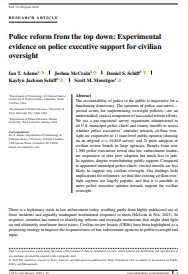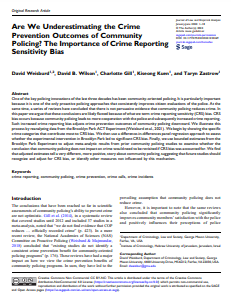By The Police Executive Research Forum
ICAT – Integrating Communications, Assessment, and Tactics – is a training program that is transforming how law enforcement officers are trained to de-escalate critical incidents and minimize the use of force whenever possible. Created and managed by the Police Executive Research Forum (PERF), ICAT was developed with input from hundreds of police officers, trainers, researchers, and others from across the United States and overseas. The curriculum includes classroom instruction split into seven modules, video case studies, and, importantly, live-action scenario-based exercises where students can practice what they learned in the classroom. Rolled out by PERF in 2016, ICAT was originally created for patrol officers, who are typically the first responders on the scene of dynamic encounters where the potential for use of force exists. Since then, ICAT has been adopted by hundreds of police departments and sheriffs’ offices across the country for their patrol divisions. And the training has been successful. In a randomized controlled study of the Louisville Metro Police Department, researchers found that ICAT was associated with substantial reductions not only in use of force by officers, but also in injuries to both subjects and officers (see page 7). Other agencies have experienced similar reductions since adopting ICAT. The good news is that ICAT is making things safer for everyone – police officers, subjects they encounter and, by extension, the community at large. The success and growth of ICAT in police departments led us to think: if the training works for patrol officers, why wouldn’t it work for correctional officers as well? After all, both groups face similar challenges. They are regularly involved in stressful, dynamic, and potentially violent encounters with people who may have mental health challenges, substance use disorders, and extensive criminal histories. In addition, police officers and correctional officers share common goals: to de-escalate these types of encounters and minimize the use of force, all while securing the safety of both officers and subjects, whether they are on the street or in a jail or prison. ICAT is built on the guiding principle of the sanctity of human life, the goal that everyone goes home safely at the end of the day. ICAT is designed primarily for incidents in which subjects are either unarmed or armed with a knife, baseball bat, or other impact weapon. The presence of a firearm changes the equation when it comes to use of force and de-escalation, and while ICAT principles can still be applied in some of these encounters, the training is largely designed for those situations where the subject is not armed with a firearm. This focus makes ICAT particularly relevant to jails, where firearms are not an issue but potentially violent inmates may still be armed with other, home-made weapons. Recently, some sheriffs’ offices that train their patrol deputies in ICAT have begun to adopt the training for their detention personnel as well. (See Chapter 3 for case studies of two such agencies: the Harris County, TX and Santa Cruz County, CA sheriffs’ offices.) They have found that not every part of ICAT applies to their jail personnel; for example, the module on “suicide by cop” is not necessarily a close fit in the jail environment. However, these agencies have discovered that the core elements of the training – communications, assessment, tactics, and decision-making – do apply to correctional officers, as does the concept of “stepping up and stepping in” with fellow officers when a situation is not going as planned. Agencies have found that the bulk of the ICAT curriculum can seamlessly be adapted for their jail personnel. The early adopters have also found that the curriculum works best when they use scenarios and video case studies that are customized to the corrections environment. (The videos and scenarios in the core ICAT curriculum focus on street encounters.) But the basic ICAT curriculum transfers easily. This publication is designed to help sheriffs’ offices, as well as other agencies that operate lockups or other detention facilities, to implement the ICAT curriculum in their facilities. This report draws heavily on the experiences of the sheriffs’ offices in Harris County and Santa Cruz County, which have been teaching ICAT to their patrol and detention personnel for well over a year. The report also reflects the ideas and insights of close to 20 individuals – sheriffs and other sheriffs’ office personnel, experienced ICAT instructors, and PERF staff – who participated in a two-day meeting in November 2022 at PERF’s National ICAT Training Center in Decatur, IL. This report is not a new curriculum for teaching ICAT to correctional personnel. What we have learned from the early adopters, as well as many of the experts we consulted with, is that the existing ICAT curriculum is a solid foundation for teaching ICAT in jails. Rather, this report serves as a guide for sheriffs’ offices that are interested in how to deliver ICAT training to their jail personnel. The following chapters summarize the key elements of the ICAT curriculum, review how they apply to correctional officers, and provide examples of how sheriffs’ offices have customized the curriculum and rolled out the training in their jails
Washington, DC: Police Executive Research Forum, 2023. 48p.




















